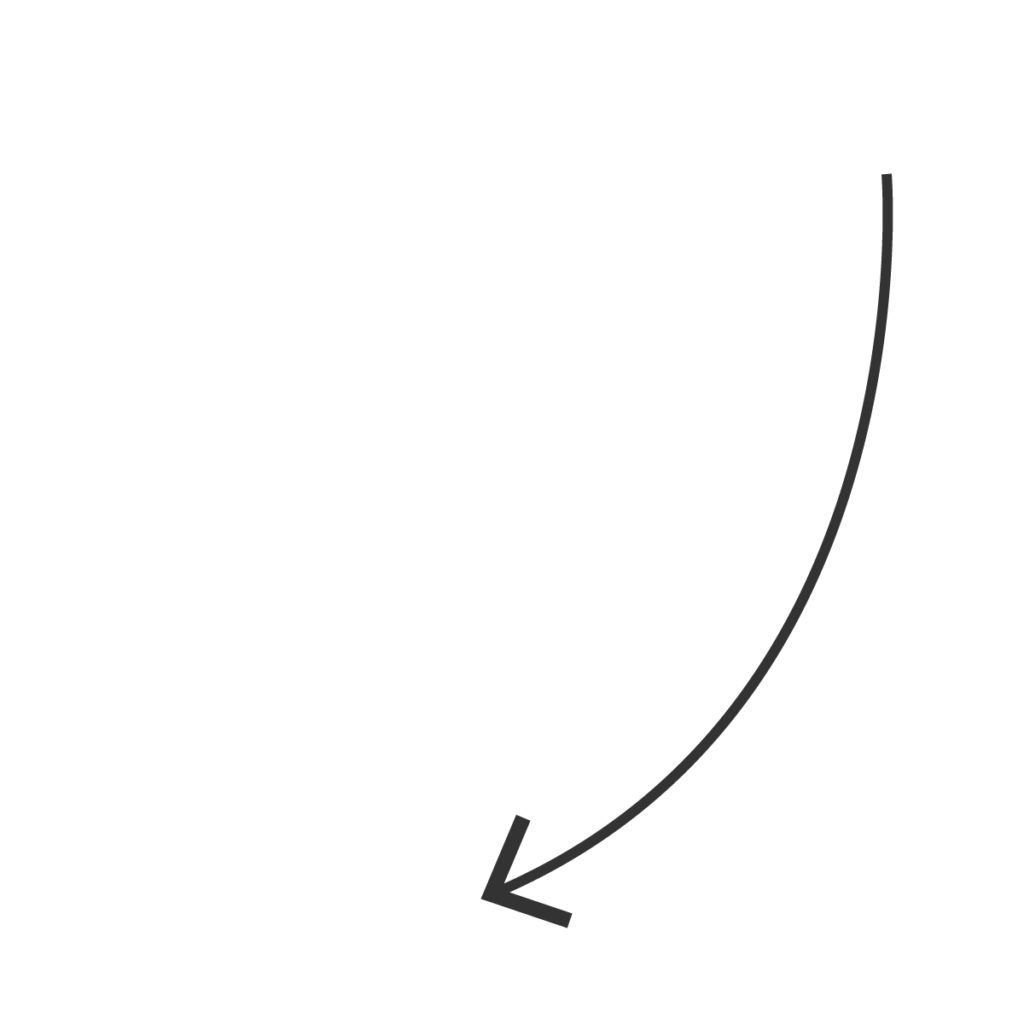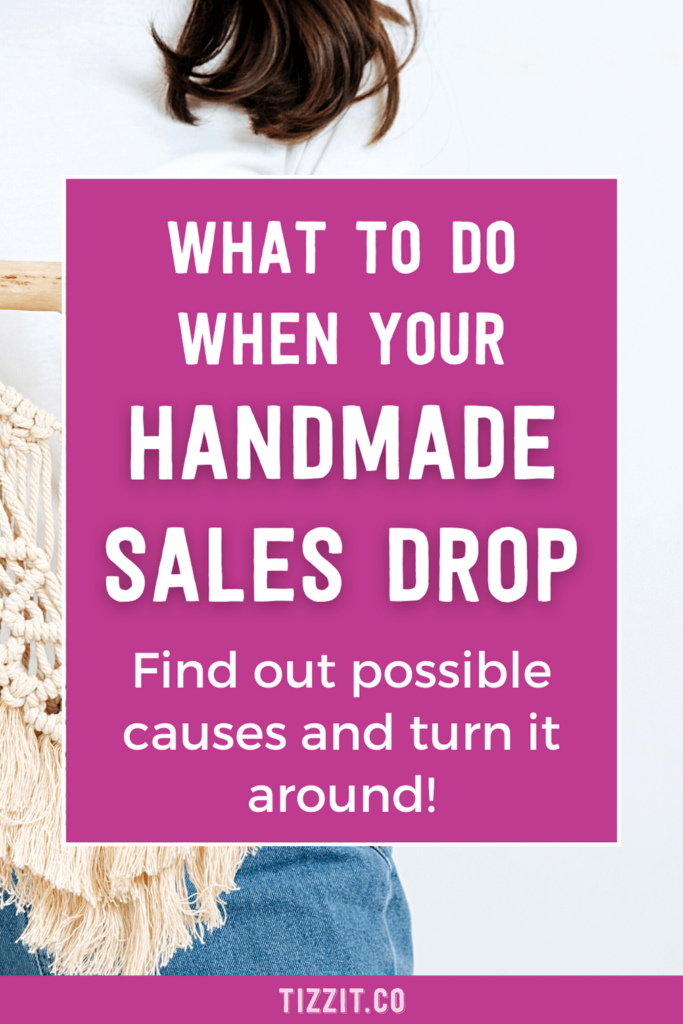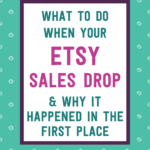top categories
Productivity + Time Management
Handmade Shop Foundations
Marketing, Traffic + Sales
top picks
Download the step-by-step Maker’s Roadmap
Grab the Handmade Pricing Calculator
join
the free
facebook group
Buy the planner
access the full library of resources for makers
What To Do When Your Handmade Sales Drop (& Why It Happened)
July 4, 2023
Every shop owner has fluctuations in sales.
And I’m betting that at one point or another you’ve experienced that momentary panicky feeling, where you notice that your sales are down and you start thinking
“Oh no!! – WHY are my sales slowing down??”
and
“WHAT am I going to do??”
Today we’re going to talk about this exact situation and the things you need to look at to break down WHY your sales are slowing down, IF you need to do anything about it, and WHAT the best thing to do is for each scenario.
So, ready? Let’s dive in.
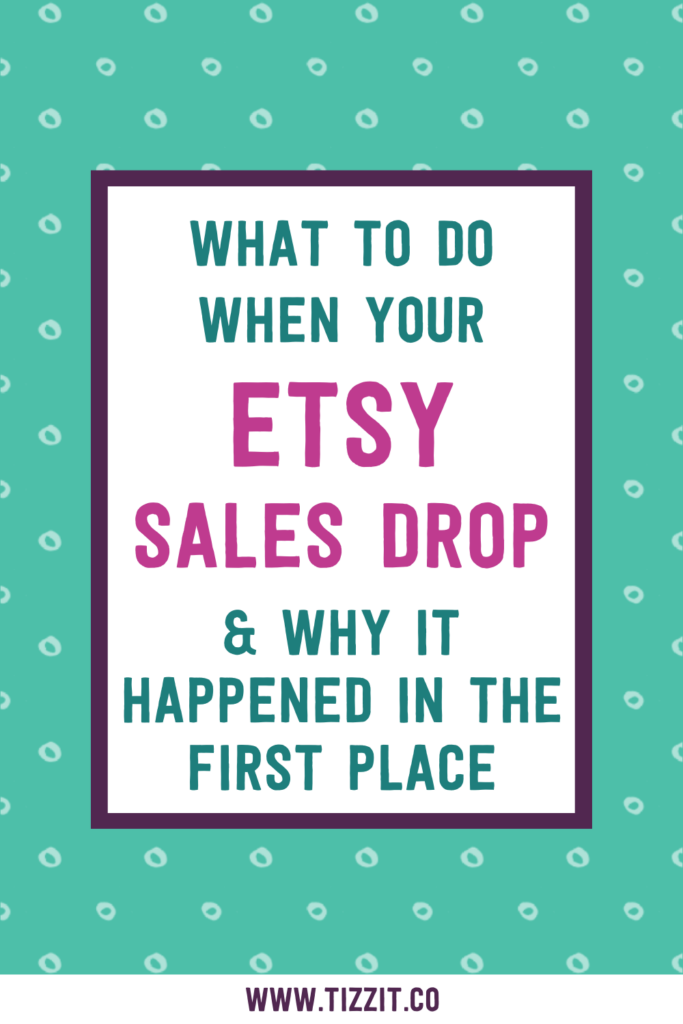
Take The Time Needed To Determine The Cause
Before we start, I want to give you fair warning that I’m going to be asking a lot of questions today and it’s important that you take the time to pause, take some notes, and answer those questions – because that’s how you investigate to find what’s actually happening and causing those sales to slow down.
There are so many things that can be behind a sales slowdown, and I can’t give you an answer like “it’s because of this thing here, and here’s how you can fix it!” But I CAN help you figure things out; we’re going to be a modern-day Sherlock Holmes and ask the questions that lead you to the answer. Then – once you have figured out why your sales have slowed down, you can RESPOND instead of REACT.
Which brings me to my first point, don’t panic!
Don’t Panic!
First off, I want to tell you to pause the panic button! I know seeing your sales slow down can be a bit worrisome, but I want you to know it’s completely normal.
You’re going to have some slow seasons — when it comes to sales, even the most successful businesses have them.
When I work with makers, they generally have one of two common reactions when they see their sales slow down:
1. “Contracting”
The first reaction that I see when someone’s sales slow down is what I call “contracting.” In this situation, when your sales slow down you feel bad, so you “contract” and do less (compared to when sales increase, you feel expansive and do more work to keep the sales going).
This is a vicious cycle, because when you do less your sales slow down even more, making you do less again . . . and things continue to get worse.
2. “Overwork”
The other reaction I see is the exact opposite: when sales slow down, you work yourself to death, exhaust yourself, and maybe even make some panicky decisions.
This is another vicious cycle, because exhaustion and bad decisions can slow down sales as well, causing more panic and overwork, and so on and so on.
The Best Response To Slow Sales
Of course it’s completely understandable that you would feel one of those two ways, but obviously neither of these responses is ideal.
What I recommend instead is to try and stay more neutral emotionally and do two things:

Get free access to our library of resources for handmade shop owners
FREE WORKBOOKS, CHEAT SHEETS, AND RESOURCES TO HELP YOU START, GROW AND PROFIT FROM YOUR HANDMADE BUSINESS.
“Accept” The Change
The first step is to accept that changes are going to occur. You want to remember that many businesses have a slow season, and that may be all this is. Ecommerce has an up-and-down rhythm, and not every month or season is a good one.
If you accept that changes in sales are part of doing business, you can avoid the negative “shutting down” or “panic” responses.
Figure out the Cause
Instead of reacting or freezing, your next step will be to figure out the cause — and this article is going to help you do this, so keep reading!
Once you know the cause of those low sales, you can work through it methodically— you can fix it, or if you determine this is a slow season and is not unexpected, EMBRACE the slow season and actually slow down yourself!
How To Determine The Cause Of Your Slow Sales
There are two main causes of slow sales: either your traffic has slowed down (and so because of that you will obviously have your sales slow down as well), or your actual sales have slowed down even with traffic staying the same (so this is an actual dip in sales).
These two things are going to have very different causes, and very different solutions. You need to methodically look over your data to determine the actual cause of your sales slowdown, so that you’re empowered to take the action needed to bring your sales back up.
Let’s go through a few examples.
Case #1: Traffic has slowed down
In case #1, you suspect that traffic to your shop has slowed down, causing your sales to slow down.
The first question you need to ask yourself is: is this really the case – is it the main reason why sales are actually slow?
If you look at your shop data and see that your conversion rate and your average order value are fairly stable but the traffic is lower so naturally your sales have dipped, you have confirmed that your sales slowdown is coming from a dip in traffic.
If that’s the case, the next step is to ask yourself if it’s seasonal — so is there a “normal” or expected reason? And if yes, what can you do?
If your sales slowdown is seasonal
Well, first, you can accept that it’s a slow season inside of your business and slow down yourself – because if you don’t slow down in the slow times, you’ll never get a break!
You can also work on things you don’t usually have time to work on, and prep ahead of time for more active months and more active seasons so that when sales start picking again, you’ve done that work ahead of time.
Another approach you can take is to try and counter these seasonal dips. Start adding different products to your product offerings that will sell during your slow season. That will help your sales levels average out because there is – more or less – always a product that’s selling.
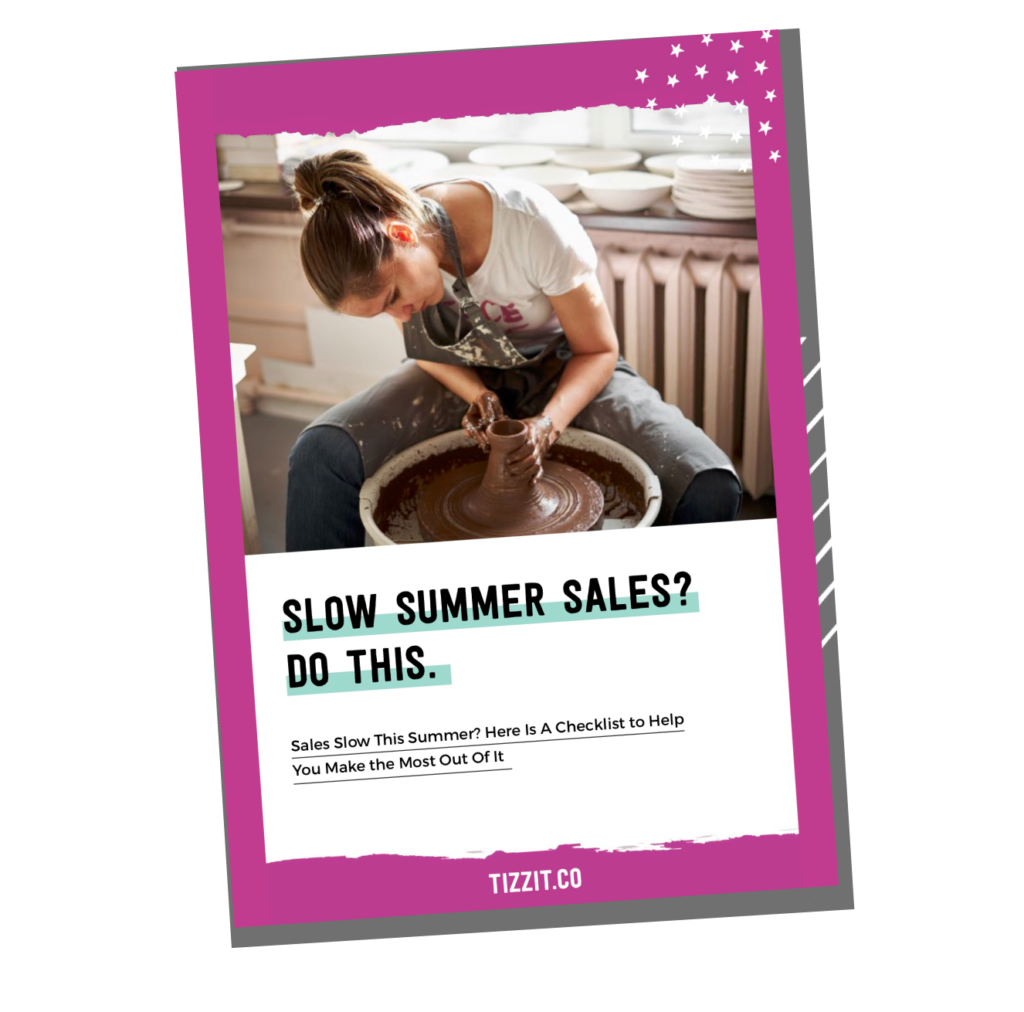
free checklist: slow sales? Do this
Are your Handmade shop sales slow this summer? Don’t worry, this checklist will help you make the most out of that time so you can get back on track.
What if your drop in sales isn’t seasonal?
Now, what if your drop in sales isn’t seasonal?
Then you need to look at your stats more closely to understand where the drop is coming from. And this is really where you need to go in with your Sherlock Holmes detective mindset!
Try not to predict what you’re going to find – staying neutral here is important, because if you don’t you might miss the real problem.
You don’t want to assume what’s working or not working, or what’s broken or not broken – and make decisions that are clouded by those assumptions.
Instead, ask yourself questions that help give context to your sales decline, so you understand what kind of decline is happening.
Take your time in this analysis, and work through these questions:
- Is this a sharp decline, or a slow decline? Or in other words, is this a recent (3 months or less) or a longer term issue?
- Did you change anything in your strategy that could explain it?
- Is it a drop, or are you coming off a “high” and this is just your sales settling back down to the normal level?
- Were you not getting a lot of traffic to start with for this product, i.e. could this be more of a fluctuation vs a real drop?
Once these elements of context are known, then you can dive deeper into your analysis and start looking at your stats for each traffic source to help find what traffic has stopped or slowed down.
For example, in question #2 you are looking to see if you changed your strategy. Sometimes changing something in your strategy can either suddenly or slowly start making your traffic a bit slower.
On the flip side, sometimes not changing your strategy can cause traffic slowdowns as well, for example if you haven’t kept up to date with the latest changes on different platforms and it causes drops in traffic. So both things are important to ask yourself.
You also want to spend time comparing the current market situation to when traffic was better and ask yourself what has changed.
Look at social media history
So for example, look at your social media posts now vs. when you were getting more traffic to your store and ask yourself all sorts of questions:
- What posts were you posting?
- What kind of engagement were you getting?
- What were those posts about?
- What were the tones of your posts?
- What were they promoting? Linking to? Which products?
- What was your strategy then, and how does this compare to your strategy now?

THIS FREE PLANNER WILL HELP YOU CREATE A SOCIAL MEDIA PLAN FOR YOUR HANDMADE SHOP. KNOW WHAT TO POST, WHEN TO POST IT, AND WHAT TOOLS TO USE!
Check traffic history of listings and keywords
If you’re looking at Etsy or similar platforms where SEO is more important, you will also want to take a look at which listings and which keywords were driving the traffic before your traffic slowed down. Has that changed?
If it has, take a look at the marketplace. Are there more competitors now for those specific listings? And do those competitors have better photos or a better price? You are looking at the things that people see straight away when they do a search, because those photos and prices are what’s going to drive traffic to your store.
Your goal is to figure out if there are external factors – so not necessarily you – that might explain why you’re starting to get lower traffic.
Another thing you will want to do is to look at your sales history to see if there is one listing that was really driving most of the traffic to your store.
When this is the case, something that I see quite often is when one product has been the main driver to your store, then suddenly more and more sellers start coming up with a product that’s very similar.
Soon this one product that was driving most of the traffic to your store starts driving a lot less traffic, and because it was the main driver of traffic to your store it results in traffic to your store becoming much lower in general.
In this case the problem was always there, it was just hidden by the fact that these one or two products were driving most of your sales, so now you’ll need to start diversifying and finding other products that are going to drive traffic so you don’t have all of your eggs in one product basket.
Don’t forget to look at the bigger picture!
Question #3 is prompting you to take a look and see if you might be coming off a high – perhaps for one reason or another and your sales notched up for a month or two, and what looks like a drop in sales is actually just your sales settling back to their normal level.
You also want to be sure that what looks like a drop in sales isn’t just a fluctuation in sales – and what I mean by that is, when you don’t have big numbers a fluctuation can feel like a big dip but it’s not necessarily statistically significant and doesn’t warrant action on your part.
So you can see in each of these cases you are looking at your sales drop in relation to the bigger picture, because sometimes what looks like a drop may not warrant any action on your part.
Case #2: Conversion rates have dropped
Next I want to take a look at the opposite situation: your traffic is the same, but conversion rates have dropped.
Has the competition changed?
If there has been more competition — in your niche, for your product, or for your store in general —or if you have products that were selling well but they’re not selling as well anymore, this often means that standards have increased.
So all the things that affect your conversion rate – photos, descriptions, product price, shipping price, shipping speed – might need to be reworked. You may have some older products that need updating, plus even not-so-old products need a re-work from time to time.
Take a look at traffic quality
Traffic quality is also important here. Many times when you see the conversion rate drop you think the listing itself is broken, but you have to consider that the type of traffic that you send to the listing is equally important.
What I mean here is that when you look at all the people who click to visit your shop, there are people that are more qualified or less qualified – so some are more likely to purchase than others.
Let’s say there was one particular traffic source that was driving most of your traffic, for example Pinterest, and that was giving you a fair bit of sales. But then that stopped, and now Instagram is sending you more traffic, and maybe Instagram sends people that are less qualified, maybe they’re a little more like your competition checking you out. So that may lower your conversion rate.
The change in conversion rate could come from within each traffic source as well – the type of posts that you create might change your conversion rate, you might have posts that are more salesy than others. Some may drive people that are really interested in buying the product straightaway, others may drive people to your store that are just checking out your products and getting to learn what you’re making.
So looking at these traffic sources, the type of posts that send the most traffic to your store, and the type of customers that they send are also important.
Beyond your conversion rate
When you have had a drop in your conversion rate you obviously want to work on it, but don’t stop there! You also want to look beyond the conversion rate, at your average order value (AOV) and the lifetime value of your customers.
It’s important to also work on boosting up your average order value, something that not many makers do, and the lifetime value of your customers as well.
I have an article all about making more money from each order that will tell you just how to do that.
Take The Time to Investigate Your Sales Slow Down
I want to repeat one more time how important it is to really take your time and analyze what’s happening so you can respond instead of react.
Once you have the knowledge of what’s changed, you have more power to course-correct. So take your time investigating and based on what you find, choose the best option for your specific situation.
You may need to readjust parts of your marketing strategy, create new products, or update current products.
You might need to accept that this is a seasonal dip that you can’t control (in which case you can rest or prepare and work ahead of time on other things).
Sometimes, you won’t find a precise cause, and that can be quite frustrating. There are cases where you will have a slower season for sales, but it won’t be seasonal and you can’t really put your finger on why it is happening. Just remember that every business has its own rhythm and each business will have slightly different low and high peaks
That is the kind of thing you will see once you’ve been in business for a couple of years and you have data to start seeing those patterns inside of your business.
Sometimes it can be especially hard the first couple of years to detect these patterns unique to your business, and if that’s the case it’s just a matter of making sure you’ve done your analysis. If after that you’re not so sure exactly why you have a slow season, accept it as it is. And either rest up, or work on those projects you’ve had on your list or on increasing your AOV.
Remember – Slowdowns Can Be Totally Normal!
Most importantly – remember that it’s TOTALLY normal to have slow times and it’s ok – and healthy – to allow yourself to slow down! We all need time to breathe and take breaks, it makes us better business owners.
Now, if I piqued your curiosity about increasing your AOV, be sure to read my article all about how to increase your average order value next!
Thanks for reading and until next time, aurevoir!
Get your hands on this free A to Z guide to starting and growing a successful handmade shop. Know what to do (and in what order) to build a wildly successful handmade shop.
download now
DOWNLOAD THE MAKER’S ROADMAP
Get your hands on this free A to Z guide to starting and growing a successful handmade shop. Know what to do (and in what order) to build a wildly successful handmade shop.
download now
DOWNLOAD THE MAKER’S ROADMAP
Leave a Reply Cancel reply
Get started right now with our free library
of resources for makers + handmade shop owners
Sign up below and get instant access to a collection of FREE practical guides, workbooks, and checklists that will help you start, grow and profit from your handmade shop. (without pulling your hair out!).
yes, free resources please!
@tizzitco
disclaimer
subscribe to youtube
become a member
get in touch
We acknowledge and give thanks to the Budawang and Yuin people, the Traditional Owners of the land we work and live on. We pay our respects to all Aboriginal and Torres Strait Islander Peoples and elders past, present and emerging.
Join Tizzit HQ
4-step Maker’s Roadmap System
Library of In-Depth Courses and Training
Live Monthly Coaching Sessions
A Supportive Online Community
Click To Get started
close x
get instant access to
the maker's roadmap
close
We hate spam too. Unsubscribe at any time.
get instant access to the free resource library
close
We hate spam too. Unsubscribe at any time.
get instant access to the free pricing calculator
close
We hate spam too. Unsubscribe at any time.
